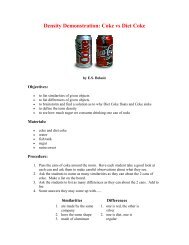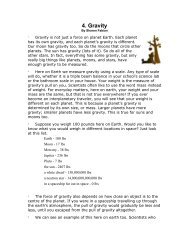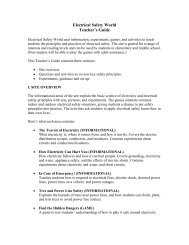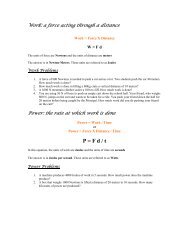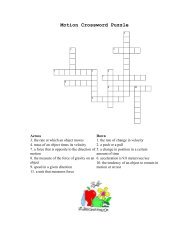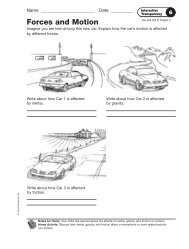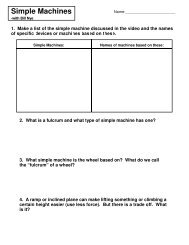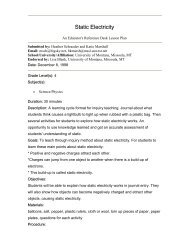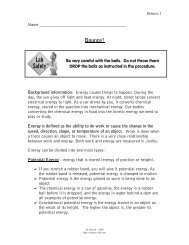Purpose: The purpose of this activity is to apply Bernoulli's Principle ...
Purpose: The purpose of this activity is to apply Bernoulli's Principle ...
Purpose: The purpose of this activity is to apply Bernoulli's Principle ...
You also want an ePaper? Increase the reach of your titles
YUMPU automatically turns print PDFs into web optimized ePapers that Google loves.
Activity One: Ping-Pong Ball<strong>Purpose</strong>: <strong>The</strong> <strong>purpose</strong> <strong>of</strong> <strong>th<strong>is</strong></strong> <strong>activity</strong> <strong>is</strong> <strong>to</strong> <strong>apply</strong> <strong>Bernoulli's</strong> <strong>Principle</strong> <strong>to</strong>understand why birds, kites, and planes can fly.Materials• 1 clean funnel with a narrow opening <strong>of</strong> 1 cm or less• 1 ping- pong ballProcedure1. Bend your head back so that you will be able <strong>to</strong> blow the pingpongball <strong>to</strong>ward the ceiling.2. Put the ball in the <strong>to</strong>p <strong>of</strong> the funnel and blow hard and fast in<strong>to</strong> thestem <strong>of</strong> the funnel.3. Record in your science journal what happened <strong>to</strong> the ball.4. Bend your head down so that you will be able <strong>to</strong> blow through thefunnel straight down <strong>to</strong>ward the floor.5. Hold the ball inside the funnel close <strong>to</strong> the hole (temporarily) andtake a deep breath.6. Let go <strong>of</strong> the ball as you blow hard through the stem <strong>of</strong> the funneluntil you use all air in your lungs.7. Record what happened <strong>to</strong> the table tenn<strong>is</strong> ball.What's Happening?<strong>Bernoulli's</strong> <strong>Principle</strong> states that when the speed <strong>of</strong> a moving fluid (air)increases, the pressure on its edges decreases. <strong>The</strong> ball clings <strong>to</strong> the funnelwhen it <strong>is</strong> pointed <strong>to</strong>ward the ceiling when the air <strong>is</strong> blown hard and fastthrough the stem <strong>of</strong> the funnel. Still air exerts more pressure around theball than that around a stream <strong>of</strong> moving air. <strong>The</strong> ball clings <strong>to</strong> the funnelwhen it <strong>is</strong> pointed <strong>to</strong>ward the floor because the air moves away from itfaster, creating a low-pressure area in the centreFrom: NASA SCIence Files..
Activity Two: <strong>The</strong> Spool<strong>Purpose</strong>: <strong>The</strong> <strong>purpose</strong> <strong>of</strong> <strong>th<strong>is</strong></strong> <strong>activity</strong> <strong>is</strong> <strong>to</strong> learn how the air pressurephenomenon works.Materials• thread spool• cardboard, 7 cm by 7 cm, lightweight but firm• pinProcedure1. Cut a piece <strong>of</strong> cardboard (from the back <strong>of</strong> a notebook) so that itmeasures 7 cm by 7 cm.2. Stick a pin through the centre <strong>of</strong> the cardboard.3. Place the spool over the pin so that the pin goes in<strong>to</strong> the hole in thespool.4. Hold the cardboard against the spool vertically. Blow firmlythrough the hole in the <strong>to</strong>p <strong>of</strong> the spool and observe what happens<strong>to</strong> the cardboard.5. Release your hand from underneath the cardboard.6. Record your observations in the science journal.Conclusion• Explain why the cardboard did not fall once you removed yourhand.What's Happening?As you blow through the <strong>to</strong>p <strong>of</strong> the spool, a jet <strong>of</strong> air moves horizontallyfrom the hole at the bot<strong>to</strong>m <strong>of</strong> the spool and spreads out over the surface<strong>of</strong> the cardboard. As the air moves rapidly out <strong>of</strong> the bot<strong>to</strong>m, it lowers thepressure between the cardboard and the spool. <strong>The</strong> higher pressure fromthe surrounding air pushes up against the bot<strong>to</strong>m <strong>of</strong> the cardboard anddemonstrates how the lift (pressure force) overcomes the weight (gravity)<strong>of</strong> the cardboard.From: NASA SCIence Files..
Activity Three: <strong>The</strong> Dime<strong>Purpose</strong>: To show the force that can be exerted upon an object by reducing the airpressure on one side <strong>of</strong> it.Materials: One dime and plate.Procedure: Place the plate on a table with the edge <strong>of</strong> the plate about 12 cm from theedge <strong>of</strong> the table. Put the dime about 4 cm from the edge <strong>of</strong> the table. Position yourmouth <strong>to</strong> blow OVER the dime and <strong>to</strong>ward the plate. Do not blow down on the dime. Usea quick hard puff and the dime would end up in the plate.Conclusion: Why did the dime end up on the plate?What's Happening? By blowing over the dime, the air pressure on <strong>to</strong>p <strong>of</strong> the dime <strong>is</strong>reduced. <strong>The</strong> dime will then be pushed up in<strong>to</strong> the stream <strong>of</strong> air by the pressureunderneath it. <strong>The</strong> stream <strong>of</strong> air from your breath should blow the dime in<strong>to</strong> the plate.Activities <strong>of</strong> the Month – April 1996Activity Four: <strong>The</strong> CupsFind two d<strong>is</strong>posable cups and some string. Cut the string in<strong>to</strong> two -1 foot long pieces.Using tape, attach the end <strong>of</strong> one piece <strong>of</strong> string <strong>to</strong> the bot<strong>to</strong>m <strong>of</strong> one <strong>of</strong> the cups, andattach the other end <strong>to</strong> the edge <strong>of</strong> a table. Repeat <strong>th<strong>is</strong></strong> with the other cup. Position thecups so they hang <strong>of</strong>f the table two inches apart and at the same height. You might need<strong>to</strong> adjust the spacing between the cups. Blow between the two cups. What happens?Why are the cups drawn <strong>to</strong>gether? <strong>Bernoulli's</strong> principle states that in areas where airmoves rapidly, pressure <strong>is</strong> low. Blowing between the cups drops the pressure so thehigher air pressure <strong>of</strong> the surrounding air pushes the cups <strong>to</strong>gether.(From NEWTON'S APPLE Educational Materials Packet)



